Tutankhamun's Death
What killed King Tut ?

When the British archaeologist Howard Carter unearthed Tutankhamun's tomb in 1922, the former propelled the enigmatic pharaoh of ancient Egypt to the rank of celebrity. Tutankhamun's sarcophagus was found almost entirely intact, unlike other known tombs of Pharaohs who were all looted in ancient times. Several objects were recovered including the funeral mask of the king, made of solid gold. After having starred in numerous exhibitions around the world, these precious antiquities are now permanent residents of the Egyptian Museum in Cairo. Unfortunately, the mummy of King Tut did not receive such special attention. It was largely damaged by Carter's team who was more interested in amulets and jewelery hidden in the bandages and on the body. It was therefore impossible to detect the cause of death at the autopsy.
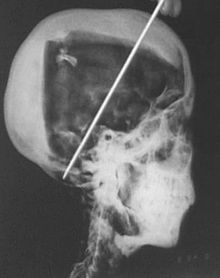
Murdered by a rival ?
In 1968, x-rays on Tutankhamun's body revealed two bone fragments inside the cranium and a dark patch at the base of the skull. This initially led people to believe that King Tut was probably murdered with a blunt object by a rival wishing to take his place on the throne. Among the potential successors to the crown are his chief adviser to the royal court, a man named Aÿ, as well as the chief of the army, Horemheb.
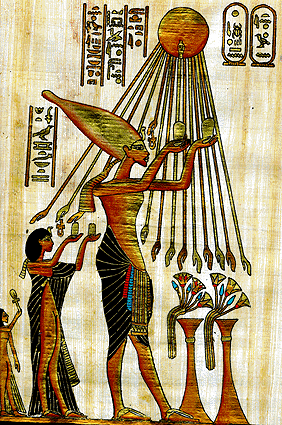
Inbred Union
Pharaoh Tutankhamun lived briefly and died at only 18 years old. King Tut lived during a period of great social and religious change. It was during this period, considered extraordinary, that Aten was worshiped, a unique god represented by the symbol of a solar disk. This religious reform has resulted in the creation of a new capital, the desert city of Amarna. Akhenaton, initiator of this transformation, wanted to move away from the ancient capital of Thebes in order to be able to govern the country without the intervention of the clergy of the old religion.
DNA analysis showed that Akhenaton is the father of Tutankhamun and that King Tut was born from a consanguineous union. This probably explains why many congenital problems were found on the body of the deceased, including a cleft lip and a club foot, according to some researchers. The tradition has been perpetrated for several generations since Tutankhamun himself married his half-sister, Ankhesenamun. Sadly, the exploration of the tomb of the late revealed the presence of two mummified bodies of stillborn girls who are attributed to this alliance.
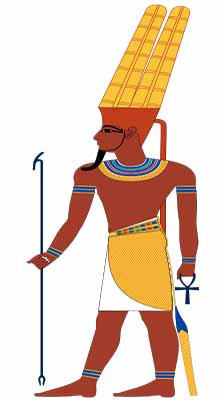
Tutankhamun, the living image of Amon
Tutankhamun was only 8 or 9 years old when he was enthroned as the twelfth ruler of the 18th dynasty of the New Kingdom of Egypt, around 1340 BC. He succeeded Smenkhkare, of whom we know almost nothing except that he reigned for four years in Amarna after Akhenaten. Being still too young to understand the full extent of his power, the young Pharaoh was highly advised by members of his royal court, including Horemheb and Aÿ. It was during his third year on the throne that King Tut put an end to the heresy of Akhenaten by restoring the old religion. The cult of Aton and the city of Amarna were abandoned to the profits of Thebes and the priests of Amon. This historic moment is further confirmed by a change in the name of the pharaoh: Tutankhaten, which means "the living image of Aton", became Tutankhamun, "the living image of Amon".
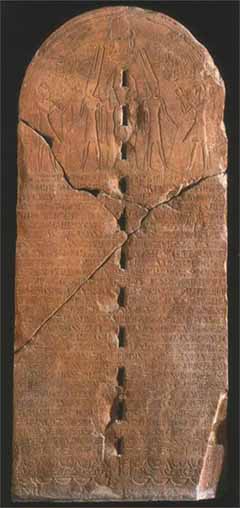
The restoration stela of King Tut is the only substantial inscription found and is the major document of the reign of Tutankhamun. Its hieroglyphs describe the state of ruin that characterized Egypt before the restoration of the old religion and how the country took the road to prosperity. A translation of an extract, more or less exact, can be read as follows:
« However, His Majesty appeared as a king, while the temples of the gods and goddesses, from Elephantine to the Delta Marshes, were on the verge of falling into ruin, while their chapels were about to fall into disrepair, transformed into ruins gained by the bushes, while their sanctuaries were as never having existed, their temples reduced to walking paths. It was in the chaos that the country was, the gods, they had turned away from this country. »
Some people have tried, after the death of the young Pharaoh, to erase his memory and that of the Amarna period by replacing the cartridges of effigies of Tutankhamun by those of Horemheb. These attempts, however, failed because the name of the savior is still legible on the stela. According to the Egyptian belief, the memory of a person must be commemorated so that it can live in the afterlife. It is through their constructions and their great actions that the pharaohs of ancient Egypt ensure their immortality.
Valley of the Kings
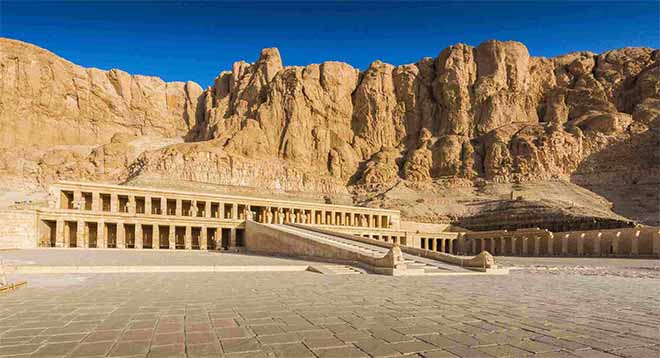
Following his death after ten years of reign, the Tutankhamun was buried in the Valley of the Kings. It is in this region located on the western bank of the Nile that resides the burial place of many Pharaohs of the New Kingdom. The tomb, carved into the rock at the bottom of the valley, is small and badly located. The murals do not seem to have been done with the care of the time and some places are not even decorated. In addition, the sarcophagus in which the body was placed was intended for someone else since the inscriptions were replaced to put the name of Tutankhamun. A huge crack is also visible on the lid, despite botched attempts to repair it. All this information suggests that someone quickly wanted to get rid of the pharaoh. The suspicions point to Aÿ, his royal court counselor, who became sovereign following the death of King Tut and is also the one who settled the funeral expenses.
Accident or murder ?
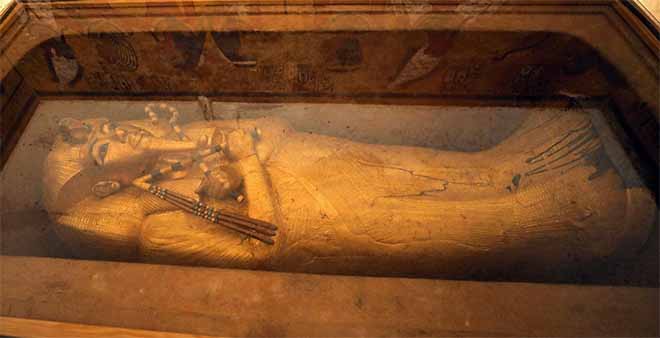
Only two reasons explain the sudden and premature death of a young man: either he was the victim of an assassination or he died as a result of an accident. In the case of Tutankhamun, all the assumptions are based on the state in which his last resting place was found. It is conceivable that his tomb was originally supposed to be temporary but that the transfer never took place to a larger grave for any reason. One hypothesis is that Aÿ, who died 4 years after Tutankhamun, decided to keep the great tomb for himself.
X-rays showing a dark spot on the back of the skull are not irrefutable evidence of a blow to the head and what's more if that shot was intentionally carried. The process of embalming involves removing the brain from the skull through the nostrils and filling the skull with resin. The black dot could very well correspond to resin residues. As for the bone fragments, they could have been dislodged during the mummification process or during the first autopsy.
Several observations, mainly based on scans and DNA analysis, reveal some possible causes of King Tut's death. Radiological imaging indicates a fracture of the leg sometime before his death and also reveals that part of his rib cage and sternum are missing. The reason for these finds is not known and it is possible that these parts were removed after his death. It is also possible that Howard Carter's excavation team damaged the body in panic and ignored the event. Another reason that could explain the death of Tutankhamun is that he had contracted a severe form of malaria, common on the continent of Africa and which can frequently be fatal.
The mystery persists
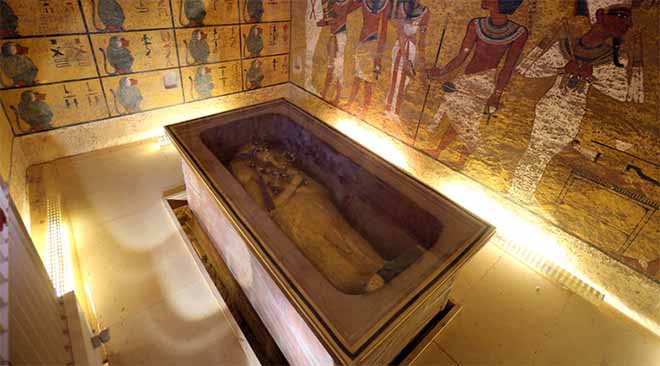
By analyzing all the elements, it is concluded that Tutankhamun probably died from a serious accident that crushed his ribs and leg. The hippopotamus quickly comes to the fore as this highly dangerous animal is an integral part of the Red Sea biocenosis and is often guilty of deadly attacks. King Tut could have fallen while hunting before being trampled by the huge beast. His serious injuries would have weakened his already fragile system from congenital diseases and malaria, causing his loss. That being said, the only sensible verdict that can be made is that the cause of his death remains unexplained. The thesis of murder remains plausible even if in all likelihood of fact it is unlikely. It can be extrapolated that he was pushed from his chariot while a hippo arrived in the opposite direction. Although Aÿ and Horemheb both had a motive for wishing King Tut's death, there is no direct evidence to implicate the suspects in a possible assassination. Even with nearly 3,500 years of hindsight and the current technologies, it is impossible to provide a definitive answer to the death of Tutankhamun, departed in the prime of life.









































































































































































































































































































































